Sausage Recipes for Popular Fad Diets
Do you ever feel like every time you turn around, there’s a new trendy diet on the horizon? Every year, it seems like the whole world is busy buzzing about the latest diet. Some are similar, while others are wildly different. A few seem pretty easy to adopt, while others seem like they require almost a complete lifestyle change.
No matter what diet you choose, it always brings the same worries and fears. Once we switch to this diet, will we have to give up our favorite foods? Will we still be able to eat our favorite recipes? Will we be going hungry because the new foods we’re eating aren’t filling? No matter how rewarding a diet turns out to be, these worries always plague us at the beginning.
When it comes to tasty treats we’d hate to give up for the sake of a new diet, sausage is high on the list. Not only is it delicious on its own, but it’s also an integral part of lots of our favorite recipes. Does going on a new diet mean saying goodbye to your sausage cravings for good?
Not at all. No matter the diet, there’s a way you can include sausage in it. While they might not be the recipes you’re used to, there are still plenty of new and exciting recipes that can help you eat sausage on popular fad diets.
We’ve compiled a list of the top 10 diets today, followed by a few sausage recipes for popular fad diets. We hope this helps you understand the differences between these dieting trends, as well as learning how to eat sausage on popular fad diets. By the time you’re finished reading this, you’ll be itching to try them.
The South Beach Diet

The South Beach diet seeks to correct the problems caused by so many fad diets. Many diets force dieters to immediately cut down on calories, resulting in uncontrollable hunger, which inevitably leads to cheating on the diet and overeating. The cycle continues, and the dieter never loses weight or becomes any healthier.
With this diet, however, the goal is to combat the hunger problem before it ever arises. Instead of starving themselves, people following this plan seek to cut out the so-called “bad” carbs that only provide fast energy and often leave them feeling hungrier than ever. Rather than eating these wasteful carbs, the dieter focuses on lean proteins, good carbs and low-fat dairy.
The goal of this diet isn’t to lose weight quickly. Instead, it’s more focused on creating a new, healthier lifestyle where you’re even allowed to indulge in the occasional treat. The goal is to reach a healthy weight and then maintain it through consistently healthy dietary choices.
Weight Watchers
This diet is so popular the odds are good you’ve known at least one person who has done it. Its popularity largely stems from the fact that it’s so easy to follow, compared to many other diets. Dieters can eat almost anything they want, provided they do so in moderation and maintain a mostly balanced diet.
The Weight Watchers plan uses a system that assigns every food a certain number of points. You record what you eat every day, adding up the points and trying to stay within your recommended number of daily points. In addition to this easy-to-follow system, this diet also offers plenty of built-in support. There are meetings — both virtual and physical — weigh-ins and groups. Between this support system and the flexible rules, there’s a lot to like about this diet.
Mediterranean Diet
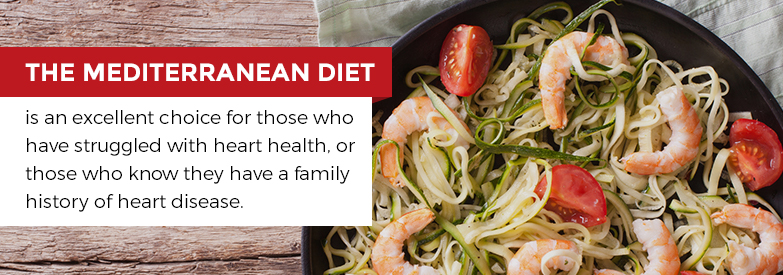
Do you enjoy seafood, red wine and tomatoes? If so, you might just love the Mediterranean diet. This system focuses on eating foods common in Mediterranean countries. It’s an eating plan that emphasizes heart-healthy, omega-3 fatty acids. The Mediterranean diet is an excellent choice for those who have struggled with heart health, or those who know they have a family history of heart disease.
Foods this diet emphasizes are seafood, fresh fruits and vegetables, whole grains, nuts and legumes, olive oil and moderate amounts of red wine.
The Zone Diet
The Zone diet operates according to the idea that by adding protein to help balance out the carbs you eat, you can lose weight, stave off chronic conditions like heart disease and diabetes and even reset your metabolism. It’s widespread among plenty of celebs, and you may have heard Jennifer Aniston famously promoting it.
Those on this diet will follow a breakdown of 30-30-40, with 30 percent of their calories coming from protein, 30 percent from fats and 40 percent from carbohydrates. This precise balance helps balance insulin levels, while controlling the hunger pangs that are the downfall of many strict diets.
The Atkins Diet
The New Atkins diet, launched in 2002, is a bit different from what you might have heard of as the “old” Atkins diet. It’s all about creating a healthy balance of lean proteins, fats and healthy carbs.
Generally, dieters start by eating as few as 20 grams of carbs per day, with this number gradually growing every week. Like many diets, the goal here is to learn to cut out any foods made with highly processed and refined sugar and flour. The Atkins diet also discourages whole-grain foods that are carb-dense.
The Paleo Diet
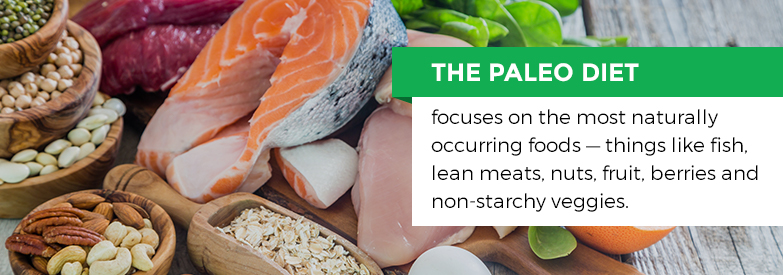
You’ve almost certainly heard of this one. You might have even heard people call it the caveman diet. The idea is that back in the dawn of time, humans only ate the most naturally occurring foods — things like fish, lean meats, nuts, fruit, berries and non-starchy veggies. The guiding principle of this diet is that these are the foods our bodies evolved to digest, and that we will be healthiest if we stick to them.
When following the Paleo plan, you must eliminate things like dairy, grains, starchy veggies and any foods that are remotely processed. The result is a protein- and nutrient-rich diet that also has a firm emphasis on proper exercise. The goal of this diet is not only to help dieters lose weight, but also to develop a new healthy lifestyle that helps them maintain their health for the rest of their lives.
Volumetrics
If you’re like most people, you know the toughest part of dieting is constantly feeling hungry. Even when you do eat, it’s hard to feel satisfied by the food, and it often seems like you’re hungry again in less than an hour. Volumetrics seeks to correct that problem by creating a diet focused on healthy foods that’ll keep you feeling full for longer.
Volumetrics does this by operating under the rule that water-dense foods are healthier than fatty or sugary foods. Foods with high water content also have the bonus of making you feel full longer, making you more likely to stick with the diet instead of cheating.
At the end of the day, Volumetrics is less of a diet and more of a lifestyle change. There are no specific rules to follow, just general guidelines about sticking with certain foods and avoiding others. The goal isn’t to lose weight, as much as it is to become healthier.
The Raw Food Diet

Those who follow the raw food diet operate according to the idea that cooking food strips it of its natural enzymes and health benefits. By cooking food, we’re effectively making it less healthy than it would otherwise be. Because of this, the raw food diet prohibits any cooked foods, which it defines as being heated above 116 to 188 degrees Fahrenheit. Other than this major restriction, dieters can choose to eat whatever they want, although the diet tends to be vegetarian for understandable reasons.
Because of the limiting nature of this diet, some people choose a modified version. They prefer to eat 80 percent of their food raw, allowing themselves to cook 20 percent, or some other similar ratio. This practice allows them slightly more variety in their diet.
As a raw food dieter, you can expect to eat plenty of salads, fruits, veggies, nuts and berries. As with many of the diets we’ve mentioned, the goal isn’t just to lose weight, although that will certainly happen as well. Rather, the goal is to become healthier in the longterm, gain more nutrients and feel more energized.
The Macrobiotic Diet
This diet is all about slowing down both your lifestyle and your eating habits, and advocates for simplicity. Dieters on this plan must avoid processed foods and focus instead on whole, natural foods. If you try this diet, you can expect to eat plenty of fruits, vegetables and whole grains.
This diet also asks you to think about more than your food choices, however. It also encourages meditation and an overall slower-paced lifestyle. While weight loss is an achievable goal with this diet, it is not the focus. Rather, the emphasis is on both the mind and the body becoming healthier through positive diet and lifestyle changes.
The Alkaline Diet
The alkaline diet is another food plan that has been trendy among plenty of celebrities, both now and in years past. The basic idea is that we should carefully balance our internal pH levels by maintaining a healthy balance in the foods we consume daily.
To do this, dieters stick primarily to foods that are alkaline-rich, such as legumes, nuts and seeds, whole grains, low-sugar fruits and veggies. On the other hand, they try to avoid more acidic foods, including bread, pasta, meat, alcohol, coffee and dairy.
The Whole30 Diet
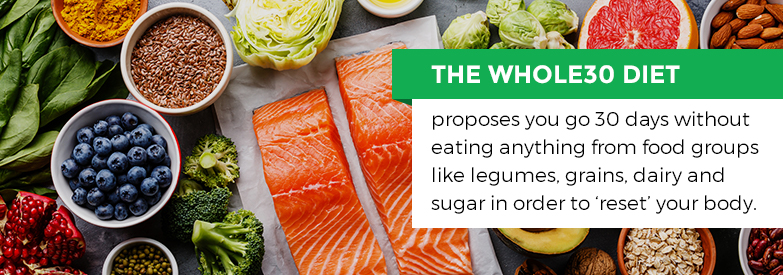
Supporters of the Whole30 Diet believe that entire food groups can affect your body negatively, leaving you feeling lethargic, your digestive tract upset and your skin irritated. To fix the problem, this diet proposes you go 30 days without eating anything from food groups like legumes, grains, dairy and sugar.
This 30-day period acts like a hard reset for your body. By purging these elements from your body, you spend a few weeks learning what your body feels like without them. Over this time, your body’s cravings change, and you can potentially retrain yourself to not want the foods that might be causing your body trouble.
While weight loss is one goal of the program, the overall focus is much more on total health and discovering how different foods affect your body overall. It’s about taking what you learn and using it to feel better, look better and function better.
Sausage on a Diet?
We know what you might be thinking. Some of these diets seem like they don’t have a lot of room for foods like sausage. Is there a way to make it work?
The answer is yes! Even though some diets might initially look like they don’t allow the dieter to eat sausage, don’t be so sure. Sometimes it just takes a little perseverance and creativity to come up with a way to eat your favorite treat that’s permissible under your new diet’s guidelines.
Take the Whole30 diet, for example. If you eat Premio’s Pepper, Onion and Mushroom Italian sausage, you’re still within the boundaries of your diet. This sausage is dairy-free, gluten-free and nut-free, contains 0 grams of trans fat, no artificial ingredients and no extra preservatives. And best of all, it tastes delicious.
By searching for sausage varieties such as this, you’ll soon find that there are plenty of ways to eat sausage even if you are on a diet.
Healthy Sausage Recipes to Try on Your New Diet
Now that you have a basic overview of a few of the most popular diets out there today, it’s time to get practical. Let’s look at a few healthy sausage recipes that have the potential to fit into multiple different diets.
-
Apple, Goat Cheese and Premio Sausage Pumpkin-Crusted Pizza
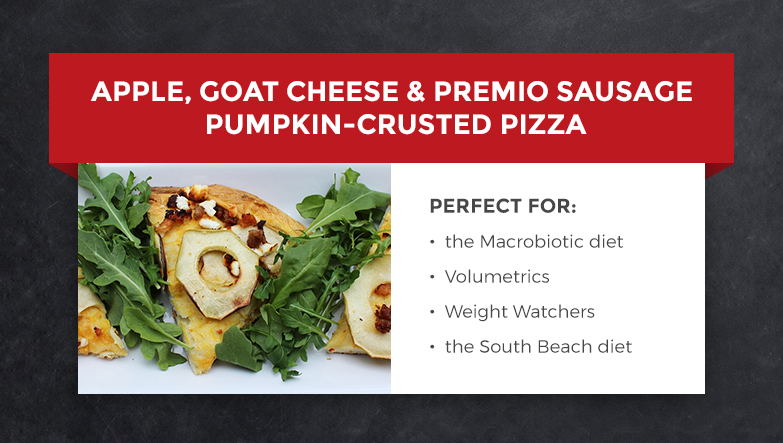
This tasty and low-carb recipe fits neatly within the bounds of a couple of the diets we’ve mentioned. It could easily fit into the macrobiotic diet, as well as Volumetrics, Weight Watchers or the South Beach diet.
In a little bowl, mix up three-quarters of a cup of warm water, one tablespoon of yeast and a third of a cup of brown sugar. Let this sit for five minutes, or until some foam starts to rise. While the yeast is sitting, take a small saucepan and fill it with three-quarters of a cup of warm water, two tablespoons of butter and two teaspoons of salt. Heat this on the stove until the butter melts, then set it aside to cool.
Combine these two mixtures into a standing mixer. Add one and a half cups of pumpkin purée and six cups of flour. For the best results, use the dough hook attachment and mix the entire creation together for about 10 minutes. At the end of this process, the dough should be sticky, but not overly wet.
Cover this bowl with a damp towel or paper towel and set it aside to rise until it doubles in size, which should take about an hour.
Next, preheat your oven to 500 degrees. When your dough has finished rising, split it in half. Sprinkle one half with flour and mold it into a ball. Roll this ball out into a crust shape of your desired level of thickness. Put it on a pizza tray and bake it for three to four minutes.
Now all that’s left is to add some toppings. Remove a package of sausage from their casings and cook them, using a spatula to crumble them up as you go. Take three apples — or more, if you like — cut them into slices and add them to the pizza. Add some goat cheese, cut into whatever size pieces you like. Put the whole thing back in the oven to bake for 10 to 15 minutes. Once you’ve removed it from the oven and allowed it to cool for a bit, it’s time to eat.
-
Premio Cheese and Garlic Chicken Sausage-Stuffed Squash
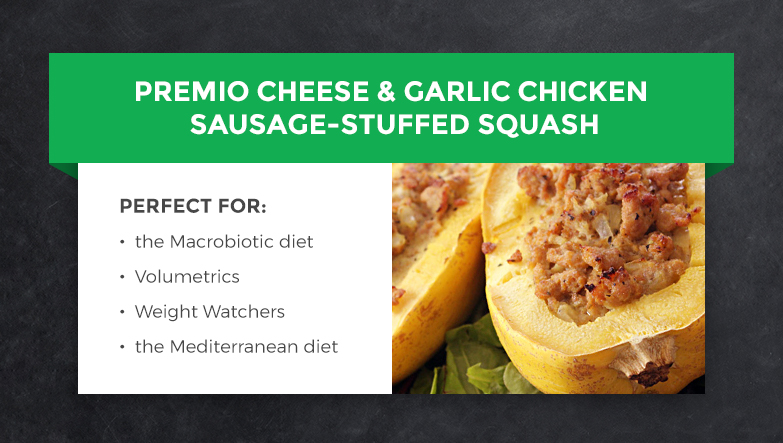
Another carb-light dish, this yummy recipe easily qualifies for Weight Watchers, macrobiotic, Volumetrics, the Mediterranean diet and more of the diets we’ve mentioned.
Begin by preheating your oven to 350 degrees. Take four yellow squash, split them lengthwise and remove the seeds. Place the cut side down on baking trays, add half an inch of water in the bottom of the trays and cook them for 10 to 12 minutes. The squash should still feel fairly firm, not mushy, when you remove them from the oven. Turn them right-side up, sprinkle them with salt and pepper, cover them and set them aside.
Put a large pan on medium heat and melt a few tablespoons of butter. Add 14 ounces of Premio’s Italian chicken sausage with cheese and garlic and cook them in the butter. Chop the sausages up into smaller chunks as they cook. Once the meat begins to cook, throw in half a cup of minced onion and keep stirring for another five minutes. Season with thyme, salt and pepper to taste. Set the whole thing aside to cool.
In a new bowl, whisk four tablespoons of oat bran and two eggs together until you’ve achieved a smooth consistency. Add salt and pepper to taste, then add this mixture to the sausage. Divide this newly combined mixture into two halves, filling each of the squash with one-half of the recipe. Bake the stuffed squash in the oven for 15 to 20 minutes.
While the squash is in the oven, mix six tablespoons of lemon juice and half a cup of olive oil. Drizzle this over the squash once it’s out of the oven and cooled down. For the best results, serve the squash in slices about an inch thick.
-
Chef Capon’s Premio’s Sausage and Clams
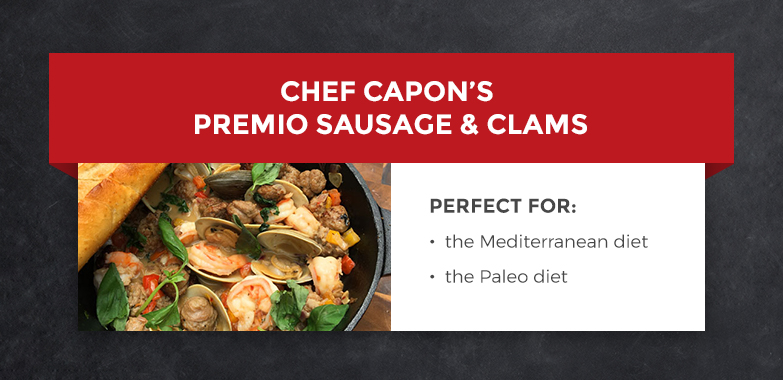
The seafood in this low-carb recipe immediately brings to mind diets such as the Mediterranean and Paleo plans. It even fits nicely into diets that encourage healthy lifestyle eating choices without strict guidelines.
To get started, preheat your grill with an iron pot over medium heat. Add half a cup of olive oil, four cloves of minced garlic and one red and one yellow pepper, both diced. Cook these ingredients until they’re a nice golden brown. Cut a package of Premio’s sausage into half-inch pieces and cook until the meat browns.
Next, add two dozen clams, two cups of white wine and four coarsely chopped plum tomatoes. Cover the dish with foil as you let the clams and the rest of the recipe steam and simmer for three to five minutes. Once the clams have opened, add in a pound of shrimp and cook everything for another two minutes.
After this mixture is finished cooking, throw in one bunch of chopped scallions, one bunch of chopped fresh basil and the juice from two lemons for a little extra flavor. Lastly, add two tablespoons of butter and stir it all together. Toast slices of baguette on your grill and serve the whole thing warm with the toasted baguettes.
-
Savory Twice-Baked Sweet Potatoes
Going on a gluten-free diet plan? That’s alright — there are still ways to get your sausage fix, and this gluten-free sweet potato dish is one of them.
Preheat your oven to 400 degrees before baking four sweet potatoes for about an hour, or as long as it takes until they’re cooked through. Using a large frying pan, cook one package of your favorite flavor of Premio sausage with the casings removed. Break up the sausages with a spoon as you go, cooking them for about 15 minutes. Sprinkle in one chopped onion and one clove of minced garlic, then cook for another five minutes and remove them from the stove.
Into this sausage mixture, add six ounces of cream cheese, two tablespoons of heavy cream, two tablespoons of brown sugar and salt and pepper. Stir the entire thing together.
Once your sweet potatoes are out of the oven, cut them in half and add your cheesy, creamy sausage mixture into the potato halves. Stick them back in the oven and bake them for an extra 10-15 minutes. Take them out, let them cool, then enjoy this gluten-free meal.
Treating Yourself on a Diet

As we hope the recipes above have demonstrated, eating sausage on popular fad diets is very possible. No matter what your health, dietary and fitness goals are, you always have choices. Some diets are inevitably stricter than others, while others leave more wiggle room, but there’s no reason you can’t still find a way to fit in your favorite treat.
A few of the diets on this list don’t prohibit sausage at all. In these cases, it’s just a matter of finding recipes that use other ingredients that fit into the diet. But there are other diets, such as ones that encourage cutting out meat, or at least cutting down on it heavily. In these cases, it’s important to remember treating yourself every so often won’t ruin your diet.
At Premio, we understand sausage is a delicious treat, and it can be hard to give it up. That’s why our website includes entire sections of recipes to fit into your diet, such as gluten-free and low-carb recipes. Not sure where you can find Premio’s sausage products in store? No worries, we also have a handy store locator so you can find the Premio distributor nearest you. And as a special gift to you, we also offer a money-saving coupon so you can get your favorite sausage flavors for less.

New York, New York
Excellent article! This author makes me hungry for some diet-friendly sausage meals! Thanks for the suggestions!